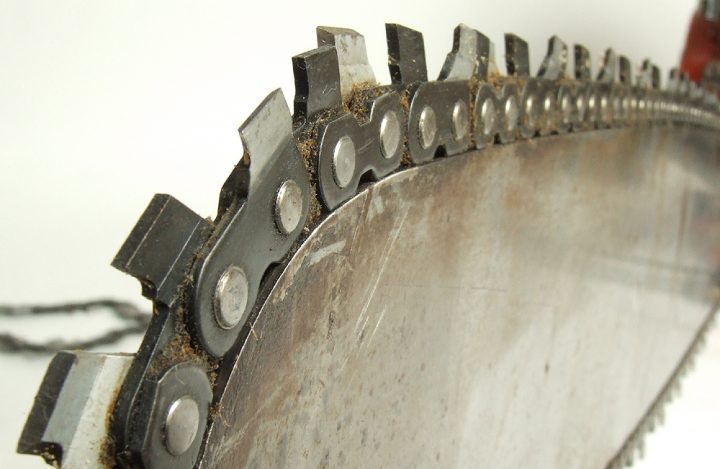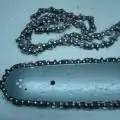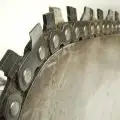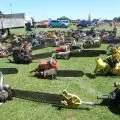Loose chains are one of the most frequent problems that woodworkers encounter. There is a chance of having to redo the work if a chainsaw chain continues falling off. Every equipment store will tell you that this occurs frequently, but how do they keep coming off?
In this article, we offer advice on the causes of a chainsaw chain coming off, along with how to prevent it from occurring in the future.
Table of Contents
- Why Does My Chainsaw Chain Keep Coming Off?
- Understanding Chain Tension
- How to Fix a Chainsaw Chain That Keeps Coming Off
- What to Do if Chainsaw Chain Fails to Tighten?
- FAQs (Frequently Asked Questions)

Why Does My Chainsaw Chain Keep Coming Off?
- Worn-out drive sprocket
- Worn-out bar heel
- Incorrectly set chain tension
- Damaged bar rails
- Material stuck on chainsaw chain
- Incorrect lubricant
Worn-Out Drive Sprocket
Due to wear and strain, the drive sprocket may be the likely culprit if the chain frequently comes off. The likelihood that they will quickly wear out is great since the drive sprocket engineers the propulsion of the chains on the chain.
Chainsaw drives sprockets that have worn out over time are no longer able to hold the chain in place or retain the proper tensile strength of the chain. As a result, anytime you are working outside in the woods, you should anticipate that the blade will frequently throw the chain off the groove.
Worn-Out Bar Heel
When the chain loses control of the guiding blade, most individuals will rapidly change the chain tension, but this is seldom a long-term fix. A qualified chainsaw service or repairer may be needed if the problem is more serious.
We also learned through our research into the issue of falling chainsaw chains that continually fall off that a worn-out bar heel is most likely to blame. But if anyone may ask, what exactly is a bar heel? The part of your chainsaw that is closest to the driving sprocket is called the bar heel.
Because the grooves lose their effectiveness as the bar heel ages, a chain travels farther. You should anticipate the chain to begin bouncing off the guiding bar as the distance between you and it grows.
Incorrectly Set Chain Tension
You may have believed that a chainsaw’s good performance is correlated with its tension, particularly when ripping firewood quickly. However, it turns out that neither overtightening a chainsaw blade nor having it too loose to develop a proper hold on the guiding bar is the proper course of action.
The catch is that if the chain on your chainsaw keeps falling off, you should examine the chain tension and determine if it is set up correctly or incorrectly.
Let’s say that with the proper chain tension, the lifespan of the bar, motor, and chain improves, as well as production. It is also important to note that the likelihood that the chain may come off is significant if there is too much slack on it.
Damaged Bar Rails
Insufficient chain tension, a worn-out drive sprocket, or a worn-out bar heel are only part of the solution to the problem of chains that keep coming off. The condition of the bar rails makes it probable that the chainsaw chain will keep falling off.
Let’s start by acknowledging that the bar rails of your chainsaw endure the most abuse throughout the machine’s productive career, especially when you are out in the woods sawing. Working at full throttle, in which case the chain spins at extremely high speeds, is among the other factors that endanger the bar rail’s longevity. Cutting into the earth unintentionally is also a real possibility.
A damaged bar rail heralds more trouble for your powerful wood-cutting machine. The most notable outcome is that the drive links of the chain will lose their smooth grip on the guiding bar. With that, you should expect chainsaw chains to come off the bar very often.
You should thus resolve the issue before continuing to saw wood in light of the aforementioned potential causes for the chainsaw blade to continually fall off. The fact that there are numerous additional reasons for the issue is also important. They include a disengaged adjustment, a loose guide bar, and insufficient chainsaw lubrication.
Material Stuck On Chainsaw Chain
Twigs, metal, and leaves can easily become trapped in chainsaws when operated at full throttle. After each use, cleaning it will help prevent materials from getting jammed. When chainsaw chains become stuck, a safety issue develops, not only leading to chainsaw kickback but also loose chains or bent chainsaw chains.
Incorrect Lubricant
It’s crucial to get the proper oil grade for the season in order to maintain the integrity of your chainsaw chains. Using the wrong lubricant can shorten the life of your machines and be one cause of the chain and blade breaking off.
There are several carefully chosen oils for various equipment, and it helps to consider the season when deciding what oil weight to use. For instance, canola oil, a bar and chain oil substitute, is advised for use on snowy days due to its high viscosity.
Your choice of oil should have sufficient stickiness to prevent debris from blocking the bar in order to reduce friction that can be brought on by a lack of oil on the chain.
Oil will thin out when being sawed in the summer, whereas it will thicken when being sawed in the winter. To avoid dry chains that could eventually loosen and fall off your chainsaw, adjust your oil as necessary.
Visit our Chainsaw Oil Types Guide to learn all about chainsaw oils and which one to use!
Understanding Chain Tension
Most importantly, remember that if you don’t understand proper tension, you can’t make the right adjustment. A lack of information about this crucial component of your machine could result in a chain that is either too tight or too loose to function properly. Let’s quickly go into chain tension so that we understand correct and incorrect tension.
Correct Tension
Pull the chain to check the tension, and pay attention to the drive links. Everything is arranged and prepared for sawing if the drive links are still in good condition. In layman’s terms, everything is fine if you pull the chain from the guiding bar and see a small space between them.
You should be aware that the gap shouldn’t be too wide because that would indicate inappropriate tension. Even if you run your machine at full throttle, chains that are too tight to move will not effectively tear the wood. The possibility of the chain breaking is always present.
Incorrect Tension
By pulling the chain from the guide bar, you can determine if the chain is too loose. A chain that readily detaches from the bar needs to be tightened right away. Examine the drive links as well. If they are not engaged, you should adjust the chain’s tension.
How to Fix a Chainsaw Chain That Keeps Coming Off
By pulling the chain from the guide bar, you can determine if the chain is too loose. A chain that readily detaches from the bar needs to be tightened right away. Examine the drive links as well. If they are not engaged, you should adjust the chain’s tension.
Step 1. Loosen the Chain
Take apart your chainsaw’s fundamental pieces to see if everything is still in working order. Check the chain for any cracked teeth or other signs of wear that could be the cause of any loose blades.
Step 2. Adjust the Tension Screw
It’s bad news if you pull the chain away from your guide bar by more than 0.5 inches. Particularly when chopping firewood, the chain teeth should have sufficient grip on the guide bar to prevent blades from falling out.
Step 3. Secure the Guiding Bar and Nuts
To prevent the blade from breaking free, it is essential to maintain rigidity in the side panel’s guiding bars, blade, and nuts. Pulling the chainsaw’s nose from the side panel to check the tension’s uniformity is the last procedure. Lift the chainsaw bar and check all angles, then screw each component to ensure that it is equally intact and fastened correctly.
What to Do if Chainsaw Chain Fails to Tighten?
- Check other components
- Remove a chain link
Check Other Components
Even after using the standard protocols, many people still wind up with a loose chain. The best course of action when handling such anguish is to examine the other components. Other components besides the sprocket, blade, and heels may be at blame for the loose chain. Here is a brief summary of the components you should think about checking.
Threads
A chainsaw chain might come off due to stripped threads as well. Establish a routine to check the fasteners’ tightness because, despite thread repairs, loose fasteners can lead to irreparable surface damage.
Tension Adjustment Screws
To replace the tension adjustment screws that are necessary during the course of a machine’s lifespan, disassemble the chainsaw’s casing. Once the screws have run their course, you’ll need to buy new pieces because repairs or calibration won’t work as a long-term fix.
Guide Bar
In sawing, guide bars play a significant role. Chains and blades are more prone to falling off when the guide bar’s grooves widen beyond the gauge that high-speed sawing is designed to create. Measure the chainsaw bar against the gauge on the guide bar to see if it hasn’t changed or if it has to be entirely replaced due to excessive wear.
To learn more, visit our How to Measure a Chainsaw Bar guide!
Wrong Chain
The right length impacts both the machine’s performance and your use. The chain comes in a variety of varieties, and mixing them together will result in inappropriate tension. To determine which chain will fit your machine and the material you are sawing, you may want to verify.
Remove a Chain Link
Depending on the type of wood you are cutting, the appropriate amount of chain links will change. For heavier jobs, more linkages are better, and vice versa. The fact that you can take out a chain link by yourself surprises the majority of people. This is frequently done to adjust the length of your chain.
However, if the chain is already worn out, it is not suggested to remove the links in an effort to restore them. This step only functions when it is adjusted to perfectly match your saw and nothing else.
It will be challenging to determine an accurate measurement when cutting or replacing links for a fresh chain because of the elastic material’s tendency to err on the side of undersizing. Instead, you can count the drive links while also taking the gauge and pitch into account.
Your starting point for determining the proper chain length for your machine will be these numbers, which are frequently mentioned in the bar. Additionally, you can choose the right length for your machine using this chainsaw chain identification chart.
FAQs (Frequently Asked Questions)
Why does my chain keep coming loose?
Your chainsaw chain is likely becoming loose due to a worn-out drive sprocket, worn-out bar heel, incorrectly set chain tension, damaged bar rails, material stuck on the chainsaw chain or incorrect lubricant.
Can you over-tighten a chainsaw chain?
Yes, you can. You will go through far too many chainsaw bars and put too much strain on the chainsaw itself if the chain is too tight. It pays to get it right because this will turn out to be an expensive mistake.
Why would a chain fall off a chainsaw?
Your chain may be coming loose for a variety of reasons, but one of the most frequent ones is that it wasn’t properly set. You must finish the procedures for tensioning your chain by setting the tension such that it won’t loosen as you use your chainsaw.






